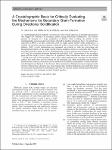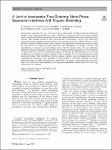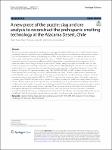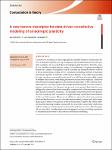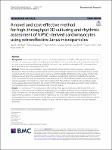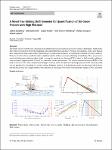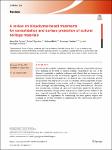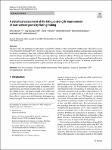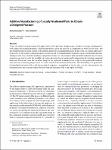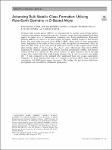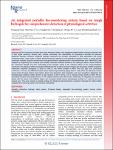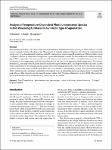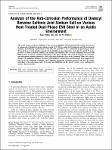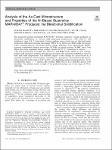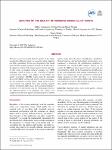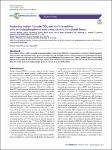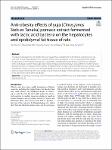Author
- Manyk, T. (3)
- Murawski, K. (3)
- Baumgartner, Jörg (2)
- Guizani, Chamseddine (2)
- next >
Subject
- SEM (2)
- TEM (2)
- 3D culturing platform (1)
- 3D EBSD orientation maps (1)
- < previous next >
Date issued
- 2023 (187)
Has File(s)
- true (187)
OER - Khoa học Vật liệu, Ứng dụng (187)
Tài liệu mở về Khoa học vật liệu, ứng dụng,....
Item Title - Ascending [/1]
The current standard method of diagnosing coronavirus disease 2019 (COVID-19) involves uncomfortable and invasive nasopharyngeal (NP) sampling using cotton swabs (CS), which can be unsuitable for self-testing. Although mid-turbinate sampling is an alternative, it has a lower diagnostic yield than NP sampling. Nasal wash (NW) has a similar diagnostic yield to NP sampling, but is cumbersome to perform. In this study, we introduce a 3D printed fluidic swab (3DPFS) that enables easy NW sampling for COVID-19 testing with improved diagnostic yield. The 3DPFS comprises a swab head, microchannel, and socket that can be connected to a syringe containing 250 µL of NW solution. |
A crystallography-based method is presented for the critical appraisal of possible mechanisms that trigger the formation of secondary grains during directional solidification. The method permits an analysis of a large population of defects, while avoiding the pitfalls of the metallographic sectioning approach that is affected by dendrite stereology. Here, the nickel-base superalloy CMSX-4, an alloy commonly used for single crystal turbine blade applications, is studied. All secondary grains originate exclusively at the external surface and when the off-axial primary ⟨001⟩
crystal orientations are measured, are evident at both the converging and diverging dispositions of the single c... |
Nano-phase separating Ni–12 at. pct Ag powders are processed via high-energy ball milling and brought into a supersaturated state with a reduction of the grain size to the nanocrystalline scale, a combination that is designed to encourage rapid densification by phase separation upon heating. This unstable powder is then characterized by dilatometry, in-situ x-ray diffraction, thermogravimetry and microstructure analysis for sintering cycles up to 940 °C. However, these powder compacts exhibit excessive pore evolution and significant macroscopic swelling caused by removal of the organic process additives. This competition of organic removal with densification is known in nanocrystallin... |
The Incas appropriated many local metallurgical technologies throughout the Andes, each of which had its unique peculiarities and was based on local ancestral knowledge. The widespread use of tin-bronze during the Inca expansion, the development of mining and smelting sites, as well as ethno-historical records evidence the Incas’ interest in copper smelting, a key activity in the Andes since ca. 1400 BC. However, little is known about the technical parameters achieved by ancient metallurgists and the changes that occurred during the Inca expansion. In this paper, we address these changes through a case study of Copiapó valley, focusing on the Viña del Cerro site, one of the most famou... |
Constitutive modeling of anisotropic plastic material behavior traditionally follows a deductive scheme, relying on empirical observations that are cast into analytic equations, the so-called phenomenological yield functions. Recently, data-driven constitutive modeling has emerged as an alternative to phenomenological models as it offers a more general way to describe the material behavior with no or fewer assumptions. In data-driven constitutive modeling, methods of statistical learning are applied to infer the yield function directly from a data set generated by experiments or numerical simulations. |
Graphene is a suitable transducer for wearable sensors because of its high conductivity, large specific surface area, flexibility, and other unique considerable features. Using a simple, fast galvanic pulse electrodeposition approach, a unique nonenzymatic glucose amperometric electrode was successfully developed based on well-distributed fine Cu nanoparticles anchored on the surface of 3D structure laser-induced graphene. The fabricated electrode allows glucose detection with a sensitivity of 2665 µA/mM/cm2, a response time of less than 5 s, a linear range of 0.03–4.5 mM, and a LOD of 0.023 µM. It also detects glucose selectively in the presence of interfering species such as ascorbi... |
Human induced pluripotent stem cell-derived cardiomyocytes (hiPSC-CMs) gain attention as a potent cell source in regenerative medicine and drug discovery. With the necessity of the demands for experimental models to create a more physiologically relevant model of the heart in vitro we herein investigate a 3D culturing platform and a method for assessing rhythm in hiPSC-CMs. |
The nature of snow and the ever-changing environment makes measuring friction on snow and ice challenging. Additionally, due to the low friction involved, the equipment used must exhibit high sensitivity. Previous investigations of ski–snow friction have ranged from small-scale model experiments performed in the laboratory to experiments with full-sized skis outdoors. However, few have been conducted under conditions similar to those encountered during actual skiing. Here, we present a novel sled tribometer which provides highly reproducible coefficient of friction (COF) values for full-sized skis gliding at relevant speeds (approximately 5.9 m/s) in a controlled indoor environment. T... |
Nowadays, the scientific community emphasizes the use of reversible and non-toxic materials in the field of cultural heritage. Biopolymers are one of the alternative materials to synthetic polymers and solvents that are dangerous for human health and for the environment, applied in consolidation and coating treatment. Natural biopolymers may be divided into polysaccharide, protein, and polyester: All of them are low cost, eco-friendly, and biocompatible, besides many physicochemical characteristics such as being transparent, soluble in water, hydrogel, and film-forming, and can be easily functionalized. The addition of nanoclay, essential oil, and active molecules improves the physico... |
A statistical assessment of the fatigue strength improvement of butt-welded joints by flush grinding All major rules and guidelines include fatigue design (FAT) classes for flush ground butt-welded joints. These FAT classes vary between FAT110 and FAT155; however, in the majority of cases, the underlying database and specimen-related details are unclear or unknown. This study evaluates 1003 fatigue test results gathered from various literature sources and tries to relate the fatigue strength improvement to typical specimen types and test conditions. To this goal, statistical methods based on correlation analysis are employed. Next, proposals for updates of rules and guidelines for flush ground butt-welded joints made of steel are established by determining new FAT classes and a suita... |
Today, the additive manufacturing (AM) approach has led to profound changes in part and process design, enabling previously impossible material properties. With the freedom to create the material as components are built layer by layer, AM has permitted precise spatial control of the material properties in manufactured parts. In this work, an original approach is proposed to locally control component and process design and create intentionally weakened regions with designed fracture, which paves the way to tuneable mechanical properties. Tensile tests of specimens with embedded weakened area of various geometries are used to verify the feasibility of a-priori-designed fracture modes an... |
Zr-based bulk metallic glasses (BMGs) are characterized by excellent glass-forming ability, combined with superior mechanical properties. However, oxygen impurities degrade both these aspects as oxides serve as heterogeneous nucleation sites during solidification. Rare-earth elements (REEs) are known to be good oxygen scavengers, binding oxygen to less harmful forms. The most stable rare-earth oxide (REO) is M2O3, which occurs in three polymorphic forms, depending on the radius of metal cation: cubic, hexagonal, and monoclinic. Here, we show the effect of Sc, Y, Lu, Nd, and Gd additions in relation to the oxygen content on the glass-forming ability of the Zr52.5Cu17.9Ni14.6Al10Ti5 all... |
Advanced soft ion-conducting hydrogels have been developed rapidly in the integrated portable health monitoring equipment due to their higher sensitivity, sensory traits, tunable conductivity, and stretchability for physiological activities and personal healthcare detection. However, traditional hydrogel conductors are normally susceptible to large deformation and strong mechanical stress, which leads to inferior electro-mechanical stability for real application scenarios. Herein, a strong ionically conductive hydrogel (poly(vinyl alcohol)-boric acid-glycerol/sodium alginate-calcium chloride/electrolyte ions (PBG/SC/EI)) was designed by engineering the covalently and ionically crossli... |
In this study, the linear free vibration of intact and cracked functionally graded material plates is investigated numerically and experimentally. The experimental work is limited to the isotropic materials. The numerical work is based on finite element, where a code is developed to obtain the natural frequencies of intact plates based on the first-order shear deformation theory (FSDT) using MATLAB software. Also, a model of through-cracked FGM plate is developed using ANSYS Workbench with the help of APDL coding. The material properties of the plates under study are graded in one, two, and three directions. The novelty of this study emerges through its examination of the synergistic ... |
Photoluminescence (PL) is one of the commonly used methods to determine the energy gap (Eg
) of semiconductors. In order to use it correctly, however, the shape of the PL peak must be properly analyzed; otherwise, the value of Eg
is burdened with a large error. Eg
is often mistakenly attributed to the PL peak position, which in type-II superlattices (T2SLs) exhibits typical “S-shaped” behavior as a function of temperature, significantly different from the Varshni model used to define the energy gap of III-V compounds. The position peak of the PL relative to the real Eg
in T2SLs is red-shifted because of the carrier localization at low temperatures and blue-shifted because of th... |
This work focuses on the investigation of the corrosion inhibition of heat-treated EN8 steel in the presence of sodium salt of dodecyl benzene sulfonic acid in 0.5 M H2SO4 using the Gravimetric and Electrochemical methods. Austenitizing is performed at 700, 750, 790, and 900 °C for 2 h followed by quenching in water. When the heat-treated metal is exposed to 0.5 M H2SO4 at the temperature of 30, 40, 50, and 60 °C in the presence of dodecyl benzene sulfonic acid sodium salt inhibitor, the corrosion inhibition increased with different heat treatment conditions depending on the phase change. This work investigates the activation and adsorption isotherm parameters. The adsorption isotherm... |
The presented research investigates MAR-M247® Ni-based superalloy castings produced via directional solidification at various mold preheating temperatures (1510, 1566 °C) and withdrawal rates (3.4, 5.0 mm/min). Casting analyses were carried out via thermodynamic simulations, differential scanning calorimetry (DSC), X-ray diffraction (XRD), light microscopy (LM), scanning electron microscopy (SEM), energy dispersive X-ray spectroscopy (EDX), scanning transmission electron microscopy (STEM), and tensile testing. On DSC curve, four effects have been registered during cooling: liquidus (1337 °C), formation of eutectic γ − γ′ (1315 °C), precipitation of Ni7(Hf, Zr)2 (1244 °C), and M5B3 bor... |
Previous research revealed that the quality of the ingots produced by different primary or secondary alloy suppliers can differ remarkably. In this way, the quality of the liquid metal and the castings produced from it can be affected by the impurity content of the ingots used as charge material. In this work, a modified reduced pressure test (RPT) technique, which is based on the remelting of samples extracted from ingots, was applied to investigate the quality of primary AlSi9Mn ingots made by horizontal direct-chill (HDC) casting and gravity casting techniques. For the evaluation of metal quality, image analysis of the cross sections was applied. Pore area fraction, number density,... |
Barium titanate (BTO) is a widely researched ferroelectric useful for energy storage. While BTO’s surface chemistry is commonly studied using density functional theory, little has been published on the TiO2 surface. Here, we determined that BTO’s surface response can be decoupled from the ferroelectric response by using a pre-optimized ferroelectric slab and allowing only the top three atomic z-layers to respond to ligand binding. Multiple favorable binding modes were identified for hydrogen, hydroxyl, water, and tert-butyl phosphonic acid on BTO’s TiO2 surface. Of these ligands, tBuPA dominates surface binding with binding energies as low as − 2.61 eV for its nine configurations. |
This study investigated the anti-obesity effects of yuja pomace extract fermented with lactic acid bacteria in rats with high-fat diet-induced obesity over a period of eight weeks. Epididymal fat cell size was significantly smaller, by about 33%, in the treatment groups given yuja pomace extract fermented with lactic acid bacteria compared to the CON group. Electron microscopic observation of hepatocyte microstructure showed that the number of lipid droplets was lower in hepatocytes, the number of mitochondria was higher, along with distinct cristae, and the rough endoplasmic reticula were well developed with stacks of cisternae and ribosomes. Thus, it is believed that yuja pomace ext... |


